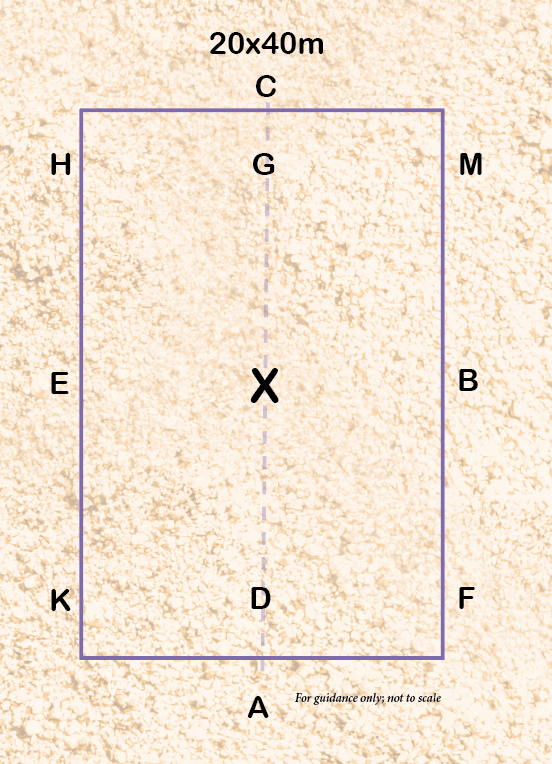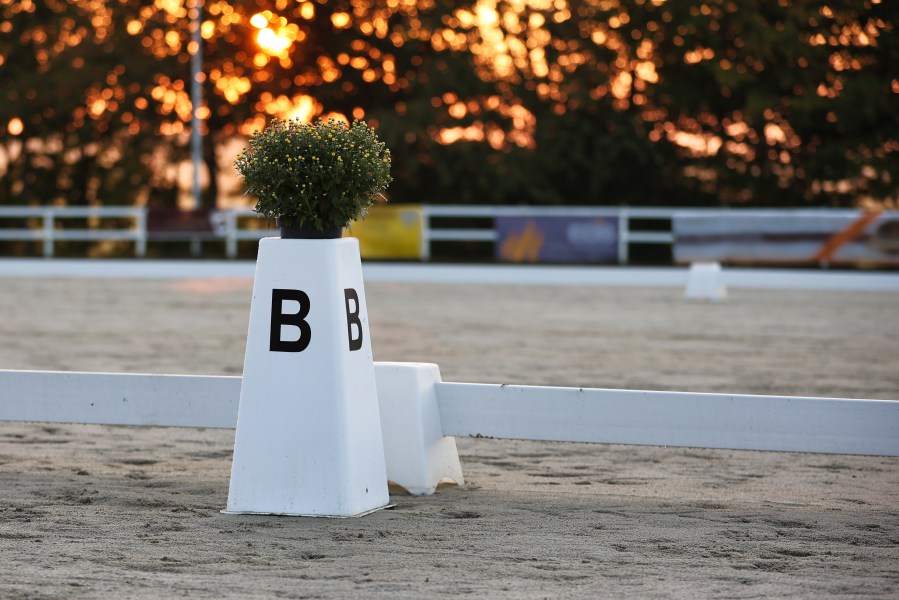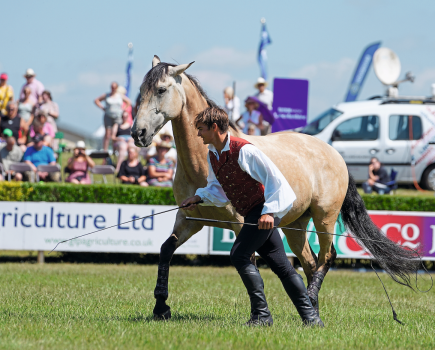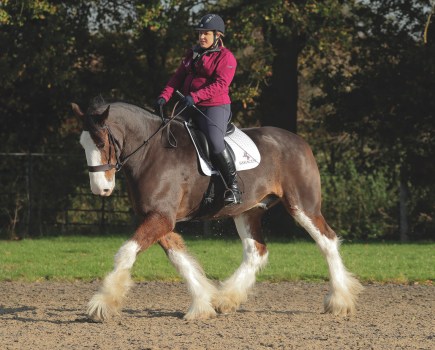The shape and layout of a dressage arena is universal across all levels of equestrian sport. Whether you are a Pony Club, Riding Club, unaffiliated or British Dressage affiliated competitor, you will find yourself riding a dressage test inside a rectangle-shaped arena marked out with black letters and white boards.
The only thing that changes is the size. At the lower levels of dressage and eventing, the arena measures 20m by 40m. At the higher levels, the arena gets slightly longer but remains the same width, measuring 20m by 60m.
Dressage arena letters
Dressage arena letters are always in the same place.
- In a 20x40m arena, there are eight letters clearly marked on the outside — three on both long sides and one each in the middle of the short sides.
- In a 20x60m arena, there are 12 letters around the outside altogether, with the markers on the long sides increasing to five each.
According to British Dressage, no one actually knows where arena letters originate from. It’s thought to be linked to Germany’s 19th century social ranking.
As well as the letters that are marked on the outside, there are also unmarked letters inside the dressage arena. These are all along the centre line (more on this later). Perhaps the two most important letters are A (where the horse enters and exits) and X at the centre of the arena.
Many riders spend their whole dressage career competing in a 20x40m arena, establishing themselves at grassroots level and having a lot of fun with their horse without the need to go further up the ladder. I personally can count on one hand the number of times I have ridden a dressage test that requires a 60m arena, and I currently have no plans to do it again.
20x40m dressage arena
Starting at A and working clockwise around the arena, the outer letters in a 20x40m dressage arena are: A, K, E, H, C, M, B and F. On the centre line, with A behind you, you reach D first, then X and finally G before turning left or right at C.
The corner letters of a dressage arena are 6m away from the corner. There is 14m between each letter on the long side (totalling 40m), while A and C are 10m in from the corners of the short sides (ie in the middle).
The first unmarked letter, D, aligns with K and F. The second, G, is in line with H and M. Both of these unmarked letters are 6m in from the edge of the arena. Meanwhile, X is always between E and B.

20x60m dressage arena
In a long dressage arena, the corner letters are still 6m in from the corners. There is 12m between the five letters on the long sides, totally the full length of 60m.
Starting at A and riding clockwise (on the right rein) around the arena, the letters are: A, K, V, E, S, H, C, M, R, B, P and F.
There are more unmarked letters on the centre line too: L aligns with V and P, while the letter I is between S and R.

Easy way to remember the arena letters
You will need to ride a dressage test from memory. Learning and remembering where you need to go depends on knowing where each arena letter is off by heart. A handy phrase to help you remember the 20x40m arena letters is:
All King Edward’s Horses Carried Many Brave Fighters
To remember the letters in a long dressage arena, try this phrase:
All King Victor’s Expensive Show Horses Can Make Really Beautiful Paces Forward
Tips for learning a dressage test
In a dressage test, you will be asked to ride certain movements at particular letters. A 20m circle starting and finishing at C, for example, or changing the rein from H to F.
The more accurate you are with these movements the higher your marks from the judge. If you make an error of course, it will cost you two marks each time. Make three errors and you will be eliminated.
Of course, you can see the outer letters as they are clearly marked, but it’s better not to have to look for them. If you know where they are without turning your head to look, you will ride a smoother test.
There are several ways to memorise a dressage test, and different things work for different riders. Here are a few ideas:
Practise on paper
Write the letters on a piece of A5 paper. Using a pencil, draw through your test. You can then rub it out and start again. There are specially designed wipe-clean boards that you can purchase for this job too.
Becky Moody, who helped Team GB to dressage bronze at the Paris 2024 Olympics, told Your Horse that drawing tests is one of her go-to methods for learning a test.
“When I was little I used to draw myself a mini ‘to scale’ dressage arena with all the letters around, and then I would draw my tests so that I knew exactly where I needed to go,” she says.
“Now when I’m riding I think about drawing the shapes in the arena surface with my horse’s feet. I’m a very visual person so I find this really helpful.”
Set up a dressage arena
Set up your own dressage arena using markers at home. It doesn’t have to be fancy boards that cost a lot of money. Painting letters on old cones or tyres, for example, works well. You don’t need an all-weather arena either. Setting up a homemade dressage arena in your field is a great idea, as chances are you’ll be riding the test on grass at a competition.
My first dressage arena markers were homemade using the lids of supplement tubs with letters painted on. They lasted years!
My first horse, Marcus, was spooky as a youngster and during his first few dressage tests, he spooked at the white arena boards. I found a few planks of wood lying around our farm, cut them down and painted them white. Because Marcus saw them every day at home, he didn’t spook at white boards in a dressage arena again.
Practise on foot
If you don’t want to ride a test in full too many times at home, you could set up a smaller version of a dressage arena and go through it on foot. This is how I learned my very first dressage test at about the age of six.
I remember weighing down paper letters with bricks and my cousins and I walk, trot and cantering on foot around our yard until we could do it error-free.
Visualise the test in your mind
You could be sitting on the sofa, mucking out, having a coffee break — anywhere you have a free five minutes to practice. Close your eyes and picture yourself riding through the test until you can do it smoothly, without having to think too hard about where you’re going next.
Say it out loud
When learning a test, it’s important to say it out loud rather than always in your head.
If you compete in dressage regularly, you’ll quickly work out what is the best way to learn a test for you. It’s a skill that develops the more you do it. Eventually, a lot of riders only have to read through a test once and they can remember it, because it triggers memories of riding it many times before.
Good luck!
Main image © Shutterstock. Diagrams © Your Horse Library/Kelsey Media Ltd










